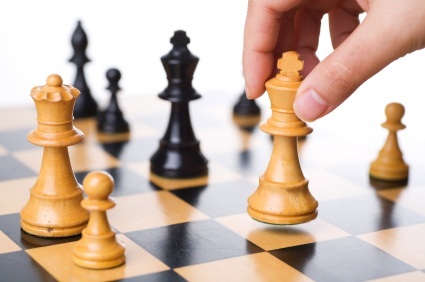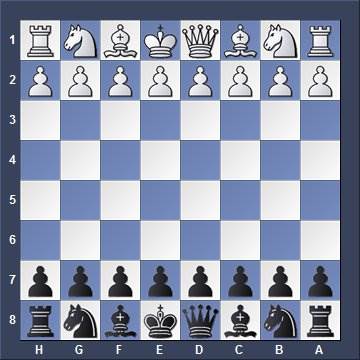Chess – The Beginner’s Guide

A hand moving the king in a chess game.
Chess
Chess is a board game that involves strategical competition between 2 players. It first originated in India. While it prospered in Europe in the time period around the 15th century, it became popular in the U.S over 40 years ago, with Bobby Fischer’s victory over Boris Spassky. The Soviet Union had dominated world chess competitions from the 1940s, until Fischer’s victory in 1972. His victory brought chess into the mainstream of American culture. In modern day life, chess has become more widespread with the development of the internet. The internet promotes more communication among chess enthusiasts around the world. It has been influential in teaching logical and precise decisions in chess.
Rules
In a “civilized” society, rules are everything. The rules of chess are the introduction to the chess world, and they are the fundamental tools in chess. The chess board, chessmen, and even manners while playing chess, have rules that must be followed.
Chessboard is a 8 by 8 game board with the arrangement of 2 alternative colors of dark and light. Each row(horizontal) is named from 1-8(with 1 on the white side and 8 on the dark side), and each column(vertical) is named from a-h. An easy way to recall the correct arrangement of the chessboard is that the right-hand corner is always a light square, regardless the side the player is on.
The chessmen (or chess pieces) on the chessboard also have their set-up rules. All chessmen on both side are placed on the first 2 rows on their side (that means the player on the white side will places his troops in row 1-2, and the player on the dark side will places his troop in row 7-8). The troop of the chessmen consists of 16 pieces on each side: 8 Pawns,2 Rooks, 2 Knights,2 Bishops, 1 Queen and 1 King. They are placed in a symmetrical way: the 8 pawns occupy all of the second rows on your side, the Rooks are placing on the corners of your end line, the Knights stands next to the Rooks, and the Bishops follows after the Knight; The King and Queen are placed in the center of your end line. The Queen takes the square of its color (white queen will occupy the light square on her side, and the dark queen takes the dark square on her side), and the King takes the other square. Such placements are called the starting positions.
When the chessmen are on their starting position, they are ready to do their work and target the opponent’s king. The white side starts his or her first move, then the dark side makes his move- then white side makes his or her second move, and so on.
Here are how the chessmen work:
Pawns are considered the soul of the chess game. During the first move of any pawn, it could choose to advance straight either one or two squares, then after its move, the pawns can only advance straight 1 at a time. A pawn captures in a different way than it moves—a pawn capture diagonally one square from its current position. After the capture, the pawn also occupies the square of the captured piece. The pawns cannot move or capture backward (toward your side). When a pawn reaches to the opponent’s end line, it can promote to a rook, a bishop, a knight or a queen, immediately. Probably due to its speed, a pawn only values as 1 point usually (point is just a way to make a brief reference to material on both sides, it is not necessary a criteria to win the game).
Rooks move horizontally and vertically, with no restriction on number of unoccupied squares. The rooks value is 5 points, and they are called heavy pieces.
Knights moves in a way of an L-shape (it moves 2 square horizontally and 1 square vertically or 1 square horizontally and 2 square vertically). They value 3 points, and they are called light pieces.
Bishops move diagonally through any number of unoccupied square, while rooks claim that they have the power of a column(vertical), bishops claim that they are strong in controlling diagonals. Each player has 2 bishops in opposite color, they never meet each other, because one of them is responsible for the light squares while the other is taking care for the dark squares. The bishops are also valued 3 points (sometimes valued 3.25), and called light pieces as well.
Queen perhaps is the most powerful piece in chess. She is the combination of rook and bishop, that means she can moves horizontally, vertically or diagonally through any number of unoccupied squares. Queen is valued 9 points in chess.
Despite the Queen is so powerful, the King is the most important piece. The King moves just like the Queen, but with a significant limitation that it can only move 1 unit horizontally, vertically or diagonally at a time. When the King is directly attacked by one, or more than one, of the opponent pieces, it is called a check. The attacking side is threatening the king on the other side, so the attacker has to call “check.” The defensive side in the check could use either of three ways to save the game: Removing attacker, interposition, or flee the king. Removing attacker is a move of removing the enemy’s piece that is checking, by your piece if available; Interposition is a move that interposes one of your piece in between the opponent’s checking piece and your king; Fleeing the King moves the king from the attack of the checking piece. If none of the three options are available, then it is called “checkmate.” The attacking side has successfully hunt down the enemy’s King, and gets the victory. If either side of the player can’t hunt down the opposing King, it is a draw. A draw can be declared by: Agreement on both players, 3-fold repetition (same moves from 2 players 3 times), stalemate (all pieces on one side cannot move but the king is not in check), and no pawns are captured in the last fifty moves. The King is invaluable, since any side that fails to protect his or her King, will lose the game.
There are some special moves in chess: Castling and En Passant. Castling is a move involving a King and a rook, and it is aimed on bringing safety to the King, and simultaneously activating the rook. Since each side has 2 rooks, there are chances to castle either rook. The rook that is closer to the King is called King-side rook, and the one that is closer to the queen is the Queen-side rook. Regardless, castling to either side requires the King moves 2 squares toward the intended side, and then placing the rook (the one the King is moving toward to) on the other side of King, and right next to the King. It counts as one move. However, this move can be executed only if certain conditions are met. The first condition is that no other pieces are in between the king and the rook (the one that is intended to castle). The second one is that the King, and the rook intended to castle, has never moved in this game. The third one is that the King is not in a check, nor its way to destination is covered by any of the opponent’s pieces, nor the destination is covered by any of the opponent’s pieces. En Passant is a French phrase, it means catching the pawn in the way. En Passant involves with only pawns, and involves of an advance of 2 square of a pawn. If a pawn is on the 5th rank, 5th row for white side and 4th row for dark side (right over the middle), and then the opponent moves a pawn that is on the column(vertical) right next to the column your pawn is, 2 squares forward, you have the option to capture the opponent’s pawn and your pawn occupies the diagonal square(the square is on the column of the captured pawn).
Note: Every piece can capture only the opponent piece, the King cannot capture an opponent’s piece if the piece is protected by another opponent’s piece (it is an illegal move, you can imagine that if the King does so, it will end up captured, which loses the game).
The manners when playing chess are also significant. Some rules are—During castling, use one hand to move the King first, and then move the rook after moving the King; Proper handshake to your opponent; Pride for yourself and your opponent—people have pride when they play chess. Try not to ask them to resign and don’t critique your moves or your opponent’s moves during the game. It may violate their “pride.”
In the modern time, there are also some different forms of chess games that are modifications of traditional chess. For instance, Fischer Random is a form of chess game invented by Robert Fischer. This form of chess randomly rearranges chess pieces on the end line, and then there is a reflection on the opponent’s side. It is also named chess 960, because there are 960 different arrangements.
Progressive Thought
During a game, both players should keep their moves in an “active way,” and the first thing to achieve that is to be active on their thoughts. Players should think mainly about 3 elements of the game: Checkmate Element, Material Element and Position Element. Checkmate is the goal of the game, therefore it should be considered first. Players should think of any opportunity to checkmate the opposing side and prevent checkmate on themselves. The next is Material Element. It is basically any chances of capturing any of your opponent’s pieces to increase the material advantage. Players should keep in mind any unprotected pieces on the opponent’s side, and their own side. If these 2 elements do not appear right away, players should still have an active mind. The third element, position might be the most critical element while playing chess. Improving the position of pieces and deteriorating your opponent’s position of pieces are very important. They decide how much opportunity will be present for the first two elements. Frequently, the combination of elements will be used during the game. Sometimes a move can have multi-purposes: like threatening checkmate and gaining material at the same time. Such strong moves should always be considered by the players. For achieving their purposes, the players even can sacrifice materials, and those sacrificial moves, usually bring more excitement to the game.
Connection to Real Life
Chess is also a game that is closely related to life. Our lives are like a chess board. We make decisions every day, that set off a chain of events, that either brings us success or failure.
The discussion of chess is not inaccessible at all. Chess websites are good source to practice chess, but also our school has the discussion of chess after school as well. It is a way to discuss chess puzzles, theory, and much much more.











